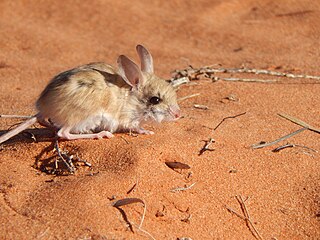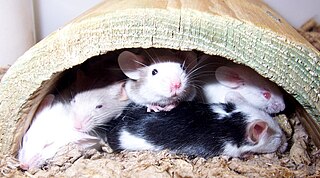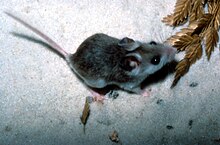
The dusky hopping mouse, is a small rodent endemic to Australia, inhabiting desert regions characterised by sand dunes. Populations have experienced significant declines since the arrival of Europeans, and continue to be subject to threatening processes. It is currently listed as a threatened species.

Peromyscus is a genus of rodents. They are commonly referred to as deer mice or deermice, not to be confused with the chevrotain or "mouse deer". They are New World mice only distantly related to the common house and laboratory mouse, Mus musculus. From this relative, Peromyscus species are distinguished by relatively larger eyes, and also often two-tone coloring, with darker colors over the dorsum (back), and white abdominal and limb hair-coloring. In reference to the coloring, the word Peromyscus comes from Greek words meaning "booted mouse". They are also accomplished jumpers and runners by comparison to house mice, and their common name of "deer mouse" is in reference to this agility.

Perdido Key State Park is a 247-acre (1.00 km2) Florida State Park located on a barrier island fifteen miles (24 km) southwest of Pensacola, off S.R. 292, in northwestern Florida. The address is 12301 Gulf Beach Highway.
The pallid beach mouse or Ponce de Leon beach mouse, is an extinct subspecies of the oldfield mouse that was endemic to Florida in the United States.

The most common rodents kept as household pets are hamsters, gerbils, common degus, fancy mice, fancy rats, common chinchillas, and guinea pigs (cavies).

Peromyscus maniculatus is a rodent native to eastern North America. It is most commonly called the eastern deer mouse; when formerly grouped with the western deer mouse, it was referred to as the North American deermouse and is fairly widespread across most of North America east of the Mississippi River, with the major exception being the lowland southeastern United States.

Preble's meadow jumping mouse is a subspecies of meadow jumping mouse, endemic to the upland habitats of Colorado and Wyoming in North America. It is found nowhere else in the world. It is listed as Threatened under the United States Endangered Species Act; there is a major debate about whether it is a valid taxon.

Perdido Key is an unincorporated community in Escambia County, Florida located between Pensacola, Florida and Orange Beach, Alabama. The community is located on and named for Perdido Key, a barrier island in northwest Florida and southeast Alabama. "Perdido" means "lost" in the Spanish and Portuguese languages. The Florida district of the Gulf Islands National Seashore includes the east end of the island, as well as other Florida islands. No more than a few hundred yards wide in most places, Perdido Key stretches some 16 miles (26 km) from near Pensacola to Perdido Pass Bridge near Orange Beach.
Bon Secour National Wildlife Refuge is a 7,157-acre (29 km2) National Wildlife Refuge located in five separate units in Baldwin and Mobile Counties, United States, directly west of Gulf Shores, Alabama on the Fort Morgan Peninsula. The refuge serves as a resting and feeding area for migratory birds and as a sanctuary for native flora and fauna. The refuge is one of the largest undeveloped parcels of land on the Alabama coast.

The Alabama beach mouse is a federally endangered subspecies of oldfield mouse that lives along the Alabama coast.
The Crocodile Lake National Wildlife Refuge is part of the United States National Wildlife Refuge System, located in north Key Largo, less than 40 miles (64 km) south of Miami off SR 905. The 6,686 acre (27.1 km2) refuge opened during the year of 1980, under the Land and Water Conservation Fund Act of 1965 and the Endangered Species Act of 1973. It was established in order to protect critical breeding and nesting habitat for the threatened American crocodile and other wildlife. This area also includes 650 acres (2.6 km2) of open water in and around the refuge. In addition to being one of only three breeding populations of the American crocodile, the refuge is home to tropical hardwood hammock, mangrove forest, and salt marsh. It is administered as part of the National Key Deer Refuge which is also located in the Florida Keys.
The canyon mouse is a gray-brown mouse found in many states of the western United States and northern Mexico. Its preferred habitat is arid, rocky desert. Vegetation has little or no effect on the distribution of canyon mice, it is instead associated with rocky substrate than any plant. Canyon mice forage in areas with shrub-like vegetation which can be used for protection against predators. It is the only species in the Peromyscus crinitus species group.

The Anastasia Island beach mouse is a subspecies of the oldfield mouse of the southeastern United States. It occurs in the sand dunes of Florida beaches. It has been classified by the United States Fish and Wildlife Service as an endangered species due to the specificity of its habitat and the natural and human-induced destruction thereof.

The cotton mouse is a species of rodent in the family Cricetidae found in the woodlands of the US South.

The oldfield mouse, oldfield deermouse or beach mouse is a nocturnal species of rodent in the family Cricetidae that primarily eats seeds. It lives in holes throughout the Southeastern United States in beaches and sandy fields. Predators to these mice include birds and mammals. In 2016, these mice were in the least concern category on the IUCN Red List with certain subspecies classified as extinct, critically endangered, endangered or near threatened.
The false canyon mouse or Coronados deer mouse, is a species of rodent in the family Cricetidae. It is known only from Coronados Island, a small island in the Gulf of California, part of Baja California Sur, Mexico. The species is threatened by predation by feral cats, and the IUCN has assessed its conservation status as "critically endangered".

The Pacific pocket mouse, Perognathus longimembris pacificus, is endemic to California. It lives in sandy coastal soils of the coastal sage scrub ecoregion. It eats seeds and some insects. It was believed to be extinct until 1993, when a small population was discovered. It is now a federally listed Endangered animal species.

Sierra Club v. Babbitt, 15 F. Supp. 2d 1274, is a United States District Court for the Southern District of Alabama case in which the Sierra Club and several other environmental organizations and private citizens challenged the United States Fish and Wildlife Service (FWS). Plaintiffs filed action seeking declaratory injunctive relief regarding two incidental take permits (ITPs) issued by the FWS for the construction of two isolated high-density housing complexes in habitat of the endangered Alabama beach mouse. The District Court ruled that the FWS must reconsider its decision to allow high-density development on the Alabama coastline that might harm the endangered Alabama beach mouse. The District Court found that the FWS violated both the Endangered Species Act (ESA) and the National Environmental Policy Act (NEPA) by permitting construction on the dwindling beach mouse habitat.
The Key Largo cotton mouse is a subspecies of rodent in the family Cricetidae. The subspecies is endemic to Key Largo in the upper Florida Keys. It is a slightly larger mouse with a more reddish color than other mouse species from mainland Florida. The Key Largo cotton mouse can breed throughout the year and has an average life expectancy of five months.

Habroscelimorpha dorsalis dorsalis, commonly known as the northeastern beach tiger beetle, is the largest subspecies of eastern beach tiger beetle. In 2012, Cicindela dorsalis dorsalis was reclassified under the name Habroscelimorpha dorsalis dorsalis, but the names are used synonymously in recently published literature. Fitting to its common name, the northeastern beach tiger beetle dwells along the U.S. northeast coast in small sand burrows. The beetle is diurnal and can be spotted by its light tan coloring with dark lines and green hues on its thorax and head.















